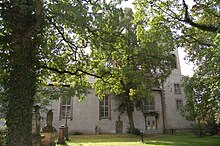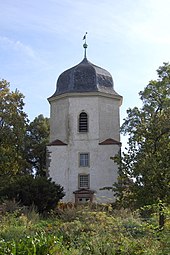St. Anna (Dieskau)
The Sankt-Anna-Kirche is the Protestant church in the village of Dieskau in the municipality of Kabelsketal in Saxony-Anhalt . It belongs to the parish area Dieskau in the parish of Halle-Saale district of the Evangelical Church in Central Germany .
History and architecture
The church was built in 1728 as a hall church immediately north of Dieskau Castle . To the west of the nave of the baroque- style church stands the steeple on a rectangular plan. In the upper part, the tower changes into an octagonal shape and is finally closed with a hood. This had to be renewed after a fire in 1932. To the south of the ship is a patron's box and Hoffmann's burial chapel from the second half of the 18th century.
The interior of the church is vaulted with a plastered wooden barrel ceiling. The pulpit altar with a curved pulpit flanked by Corinthian columns dates from around 1730. Above the sound cover there is a pelican figure under a glory of rays . A lectern and a baptismal frame with rich carvings are also noteworthy . The organ prospectus dates from between 1750 and 1775.
Access from the nave to the burial chapel leads through a round arch, which is flanked by wooden Tuscan columns . The chapel itself is crowned by a drum dome . What is striking in the chapel is an illusionistic architectural painting , for example pilasters are depicted on the walls and cassettes in the dome. In the chapel there is a marble tomb for Johanna Theresia Augusta von Hoffmann , who died in 1770 , wife of the Chancellor of the University of Halle, Carl Christoph von Hoffmann . The tomb was probably created by Friedrich Samuel Schlegel based on a design by Adam Friedrich Oeser and is considered a major work of Leipzig's early classicism. It shows a mourner leaning against an urn pillar and two weeping putti in front of it . An epitaph for Carl von Dieskau , who died in 1721, stands on the north wall. It is also made of marble and has an inscription tablet surrounded by a heraldic frame serving as an ancestral test .
A carved figure of Anna selbdritt , presumably made in Erfurt , is dated to around 1520. Her right arm, which is actually holding the baby Jesus, has broken off along with the child figure.
From 1892 to 1927 the theologian Robert Pasche was pastor at the church.
The colored glass windows created in 1947 by the Ferdinand Müller stained glass house depict the resurrection of Christ.
On the outside of the church you can see an epitaph created around 1760 for Christian Friedrich Hübner and his wife. The cemetery surrounding the church has various baroque and classicist tombs.
organ
The organ was built in 1916 by the organ builder EF Walcker & Cie. (Ludwigsburg) built. The pocket store instrument has 15 stops on two manuals and a pedal . The actions are pneumatic.
|
|
|
|||||||||||||||||||||||||||||||||||||||||||||||||||||||||
- Coupling : II / I, I / P, II / P, as well as sub- and super octave coupling, melody coupling and bass coupling (manuals)
See also
literature
- Dehio, Handbook of German Art Monuments , Saxony-Anhalt II, Dessau and Halle administrative districts , Deutscher Kunstverlag Munich Berlin 1999, ISBN 3-422-03065-4 , page 153
Web links
Individual evidence
Coordinates: 51 ° 26 ′ 6 ″ N , 12 ° 2 ′ 19 ″ E


